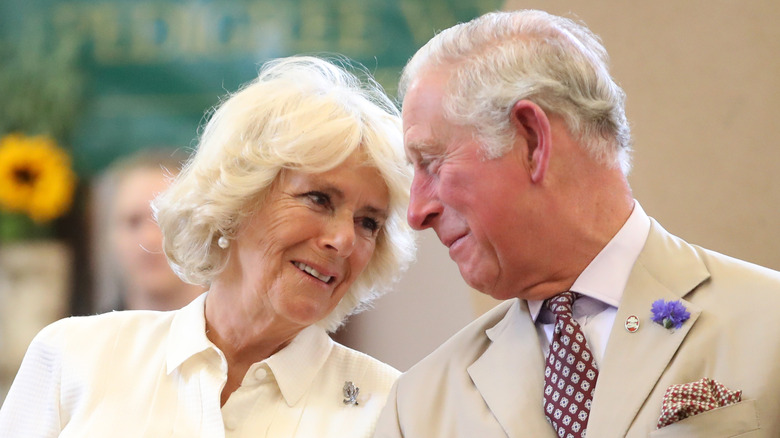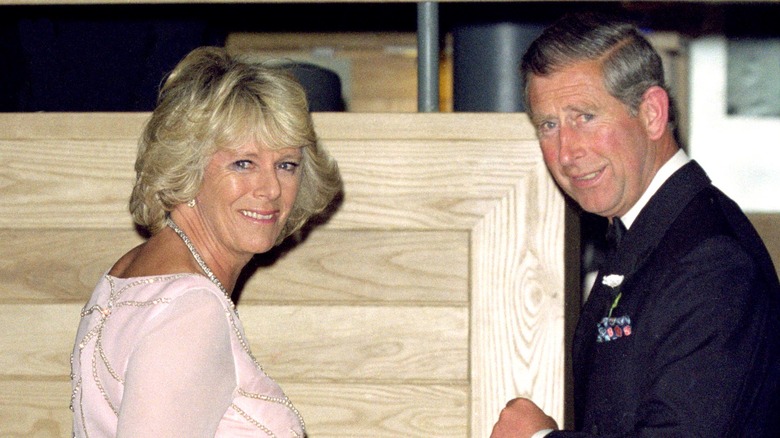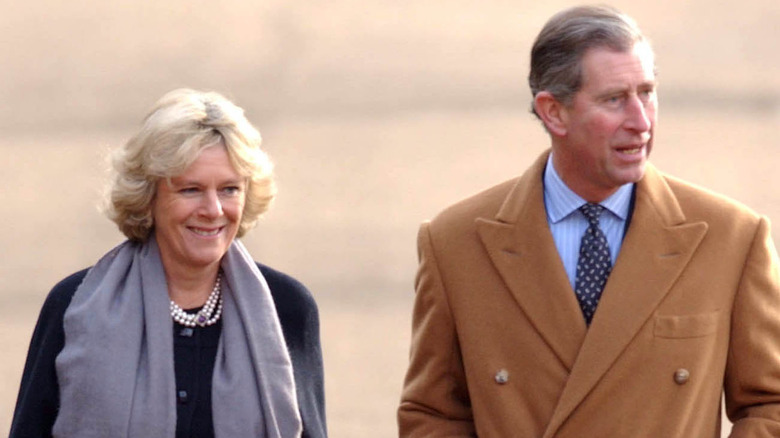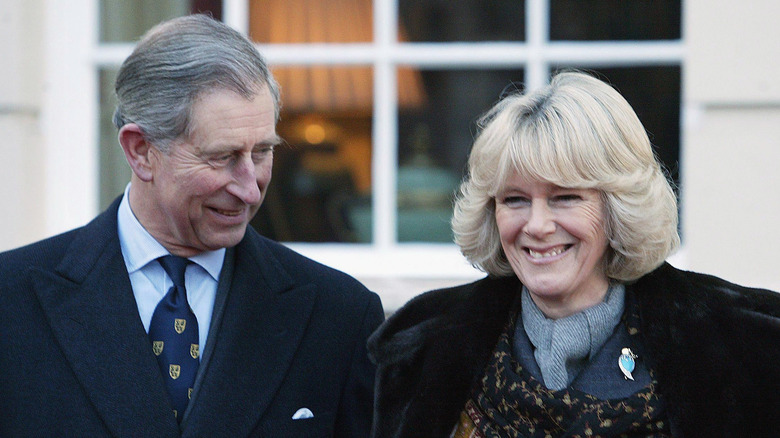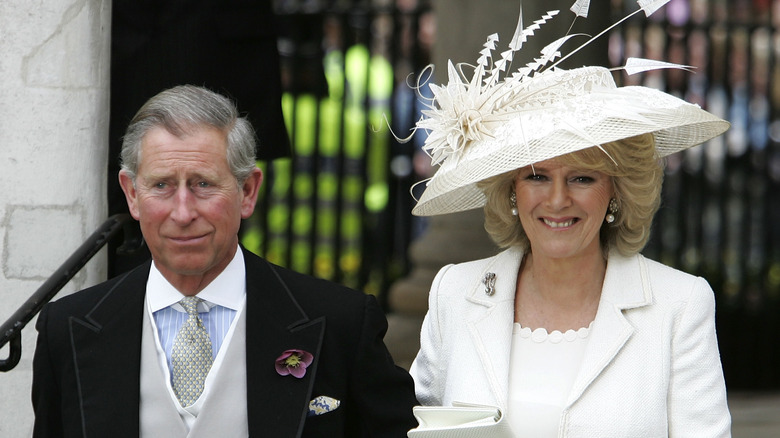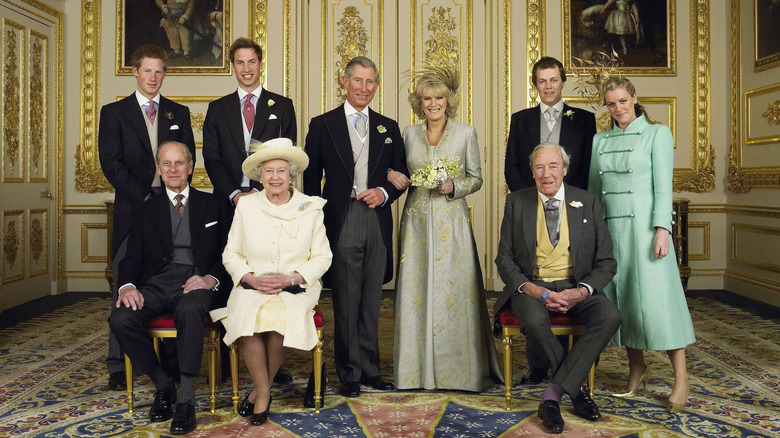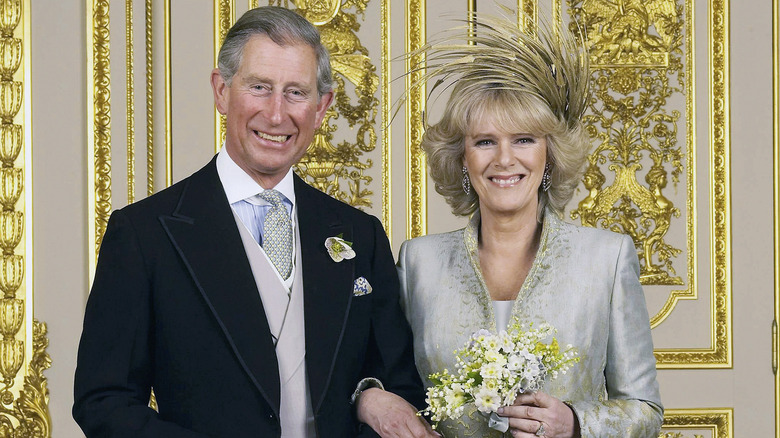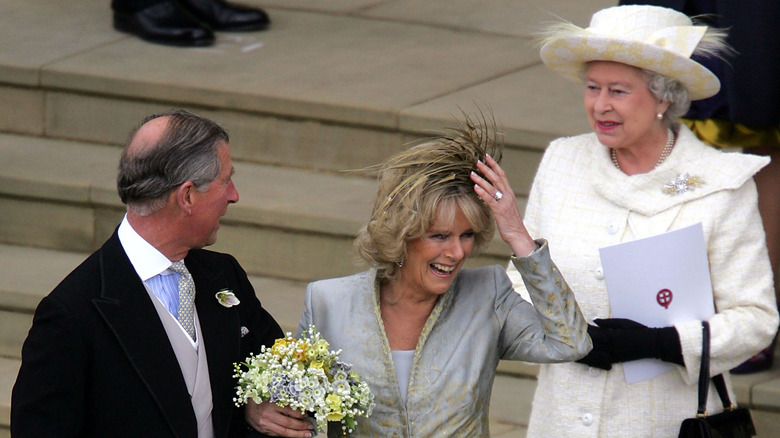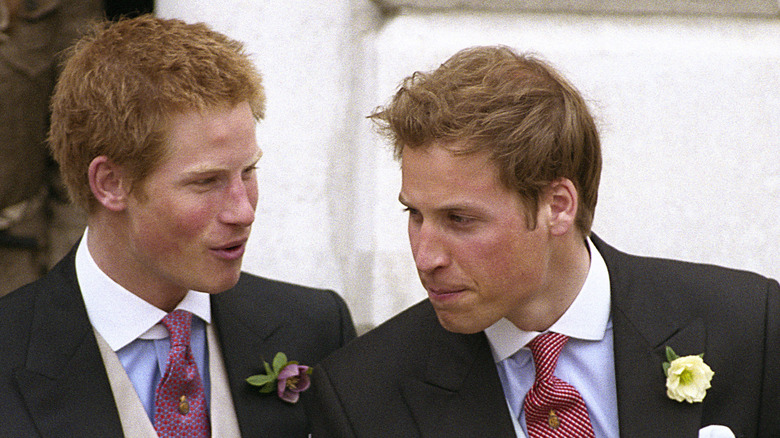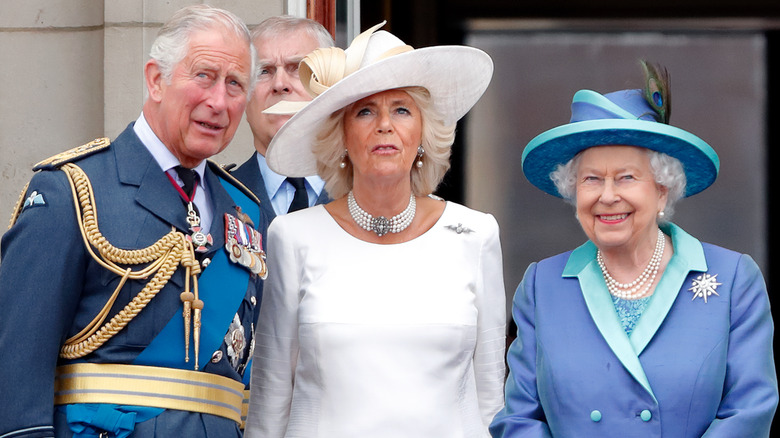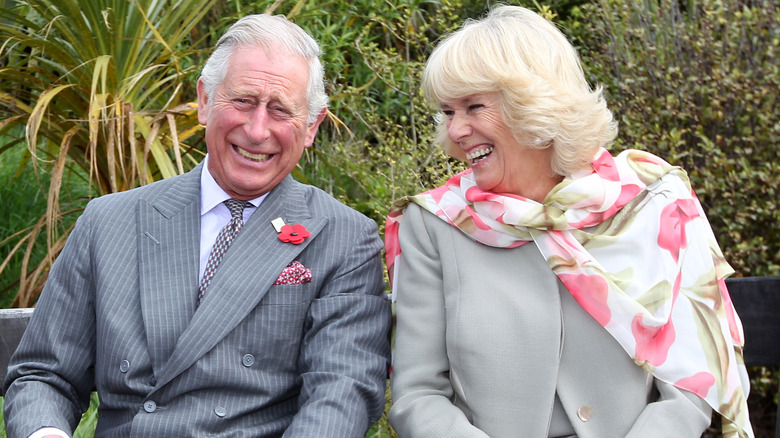What King Charles And Camilla's Wedding Was Really Like
Few royal romances have been as defiant and persistent as the one between King Charles III and Queen Consort Camilla. The couple, which is all set to preside over the United Kingdom as Charles prepares to take over the British throne as monarch, has shared a love that goes back over 50 years. At the time that they first met in 1970 and something sparked, Charles and Camilla were probably too naive to predict that it would be a long time before fate brought them together for life. From holding on through their respective first marriages to bracing for mass reproval, the two senior royals weathered a storm of circumstances to be with each other. The most consequential one, of course, was winning support from Charles' mother, the then-reigning Queen Elizabeth II.
It is widely acknowledged that the late queen wasn't immediate pals with her son's romantic partner, who was notorious in Britain as one of the primary targets behind the breakdown of Charles' marriage to the beloved Princess Diana of Wales. According to Charles' ex-staff member, it didn't help that the media bolstered Camilla's image as "this evil, horrible person," Vanity Fair noted. It took years before Elizabeth approved her son's one true love and, in seeming culmination of her acceptance of Camilla, expressly named her as her choice for queen consort during her final months. Let's look back at their legendary romance — from how their relationship kickstarted, to what King Charles and Camilla's wedding was really like.
Charles and Camilla wed after a long courtship
Before formally saying their "I dos," King Charles III and Queen Consort Camilla had a courtship that lasted longer than many marriages do. The royal pair's love story is also among the most famous of all time, given that it transpired over decades in bold defiance of their spouses and social convention. Camilla and Charles first crossed paths in 1970 at a polo match, with the future king of Britain apparently left infatuated on the spot. In her royal biography of Camilla, Penny Junor wrote, "[Charles] was very taken with her and after that first meeting he began ringing her up" (via People). As it happens, life intervened and set the two on different paths; Camilla married army officer Andrew Parker Bowles, while Charles introduced Britain to its new Princess of Wales, Diana Spencer.
It turned out that the sun never really set on Charles and Camilla's brief romance. As Diana would go on to proclaim in her infamous 1995 BBC interview, "There were three of us in this marriage, so it was a bit crowded." According to tapes from 1991 released by National Geographic, Diana even confronted Camilla about her clandestine affair with her husband. "I obviously am in the way and it must be hell for both of you," Lady Di told Camilla. The lovers eventually split from their respective partners and pursued a long-term commitment, before moving into Clarence House together in 2003.
The nuptials were postponed at the last minute
Over three decades after they first fell for each other, King Charles III and Queen Consort Camilla decided to formalize their relationship in 2005. Early that year, the couple announced their engagement, with a statement from Buckingham Palace expressing Queen Elizabeth II's happiness for her son's union. The sound of wedding bells seemingly blocked out the queen's past objection to Camilla, whom she allegedly once referred to as a "wicked woman," according to Katie Nicholl's book "The New Royals" (via Insider). Though it would take the British public more time to accept the Prince of Wales' to-be wife, whose burgeoning public image as "the other woman" attracted mass cries of disapproval, the monarch gave her blessings to the couple. Rather symbolically, Britain's most controversial royal wedding wouldn't be consummated so seamlessly.
Camilla and Charles' long pending nuptials hit another delay with the death of Pope John Paul II. The funeral was scheduled to take place on April 8, 2005, the same day Charles and Camilla had arranged to tie the knot. According to The Guardian, the ceremony was postponed by a day, with the Prince of Wales (as well as a number of other British dignitaries) flying out to attend the last offices of the head of the Catholic Church in Rome. Back in Windsor, the last-minute change-up had coordinators on their feet. In royal florist Simon Lycett's words to Hello! magazine, it was all "a bit of a white-knuckle ride."
Camilla wasn't ready to get out of bed on her big day
Weddings carry a notorious reputation for leaving even the most lovesick brides-to-be with a bad case of cold feet. But that's not why Queen Consort Camilla, who had been yoked to King Charles III for the better part of her adulthood, was incapable of getting out of bed on April 9, 2005. At least, that wasn't the whole reason. She hadn't been keeping well in the week leading up to her wedding day and was apparently down with sinusitis, Vanity Fair noted. The future royal's close friend Lucia Santa Cruz — who had played cupid to Charles and Camilla all those years ago, and also briefly dated the young prince himself — recalled that Camilla was "was really ill, stressed."
Her impending nuptials also added to her anxiety, which couldn't be quelled by a room full of her closest associates. It was all probably a little too off-brand for the rock-confident Camilla, who friends had described as a "deeply un-neurotic and well-grounded person" to Independent.ie. They further gushed about how she was an ideal match for Charles, known for being the shyer of the two. "[S]he will be the perfect consort figure: partner, rock, comfort, generator of stability," they said. It was only when Camilla's sister threatened to slip into her wedding dress that the bride got to her feet. Camilla's memorable wedding wardrobe was a whole iconic moment of its own, discussed further ahead in the article.
Charles and Camilla had a muted civil ceremony
King Charles III and Queen Consort Camilla's nuptials, like their long-term romance, weren't normative by any royal standards. The couple kicked off the two-part occasion first at the Windsor Guildhall, where their union was given legal recognition in a civil ceremony. The short private affair included a limited number of family members and after the deed was done, the newlyweds emerged from the town hall to the sound of jazz musicians playing "Congratulations," the Associated Press reported then. In keeping with their consistent break from tradition, Charles and Camilla ditched the royal public kiss to merely smile at the crowd of thousands collected outside. As Independent.ie quoted, Camilla described her wedding as "two old people getting hitched."
The royal pair, both divorcees, waived the optics of a grand wedding ceremony to avoid any additional controversies in their already controversial match, which was yet to win full approval from the British people. In honor of the mass sentiment, it was also acknowledged that Camilla would assume the title of Duchess of Cornwall and respectfully not replace the late Diana, Princess of Wales in her role. According to The New York Times, Charles and Camilla drove up from the Guildhall to Windsor Castle in the monarch's Rolls-Royce, for a religious ceremony at St. George's Chapel. This event, more conventionally celebratory, was televised for the world and had a host of important dignitaries in attendance — including the queen.
Queen Elizabeth did not attend the royal wedding
Queen Elizabeth II's demurral for the union of King Charles III and Queen Consort Camilla was an open secret in Britain. So when the monarch skipped her son's legal ceremony at the Guildhall in Windsor, murmurs of her enduring disapproval for the newlyweds were only inevitable. However, as Buckingham Palace made plenty clear, the queen's absence from Charles' civil wedding wasn't a snub. Per The Washington Post, the palace said in a statement, "The queen will not be attending the civil ceremony because she is aware that the prince and Mrs. Parker Bowles wanted to keep the occasion low key." But there was more to the matter than met the eye.
It was only in 2002 that The Church of England acknowledged and paved the way for couples of the faith to remarry in church after divorce. In the case of Charles and Camilla, the then-Archbishop of Canterbury personally offered his full support to the union. Per The Guardian, he said in a statement, "These arrangements have my strong support and are consistent with Church of England guidelines concerning remarriage." While the queen witnessed her son's blessing ceremony at Windsor Castle, she obliged her commitment to the church and gave the town hall congregation a miss. She was allegedly quoted telling a friend, "I am not able to go. I do not feel that my position permits it," reported The Telegraph, further observing that the queen hasn't ever attended a civil wedding.
Camilla changed into two wedding outfits but skipped the tiara
Royal fans around the world were eager to see how Queen Consort Camilla's wedding wardrobe would match up to their past favorite royal wedding looks. Unlike her predecessors, Camilla got more than one opportunity to deck up on her D-day — and, according to expert consensus, she passed with flying colors. For her civil ceremony, the Duchess of Cornwall wore a Robinson Valentine piece with cream-hued silk and chiffon detailing. The accompanying straw hat was, of course, the art of the royal family's go-to milliner Philip Treacy. To complement the muted tone of the outfit, makeup artist Julie Biddlecombe "went for the no makeup look, illuminating her skin and cheekbones," Vogue quoted.
As noted fashion journalist Sandra Boler observed, Camilla's first dress was ideal for the ceremony at Windsor's town hall. "The color is right, the style is right – it is elegant and gently romantic," she told the BBC. The second dress, which Camilla wore for the official reception at St. George's Chapel and which was way more unforgettable, was a silken porcelain blue number with intricate threadwork. The most curious detail, however, was the gold feathered headdress that rested on Camilla's head in place of the customary tiara. It was widely understood that since it was Camilla's second wedding — and notably one that wasn't held in a church like royal weddings typically are — she forewent the tiara.
Queen Elizabeth broke a custom at her son's wedding
The royal class seldom likes to part with its established customs — most of all the monarch, who is expected to preside over its functions. But queens can be rule breakers, too. The then-reigning Queen Elizabeth II bypassed tradition at her son King Charles III's nuptials at Windsor Castle by showing up in an all-white ensemble. At a wedding, that color is typically reserved for the most important person there: the bride. Interestingly enough, the no-white rule Elizabeth breached was one historically started by her great-great-grandmother Queen Victoria, who opted for a white gown at her own wedding in 1840. But since little about her son's second wedding conformed to old traditions, Elizabeth presumably saw it safe to indulge in a little harmless rebellion herself.
Anyhow, there was no issue of Her Majesty's white dress clashing with that of the bride Queen Consort Camilla, who had donned a blue silk gown and was dealing with far more concerning wardrobe troubles that day. As recalled in a heartwarming tribute to the queen after her death in 2022, Camilla had, in a moment of inattention, slipped on shoes with varying heel lengths for her blessing ceremony at the chapel. "I was halfway down in the car before I realized," she said, as quoted by Newsweek. Elizabeth, with her legendary sense of humor, noticed the faux pas and couldn't hold in her laughter. She did offer her daughter-in-law her sympathies though.
Charles' sons weren't totally in favor of the marriage
Less than a decade after the death of their mother Princess Diana of Wales, Princes William and Harry stood witness to their father's remarriage in 2005. From the civil ceremony to the blessing reception at the royal estate, the siblings were right by King Charles III's side as he said his "I dos" to his longtime partner, Queen Consort Camilla. While smiles in support of their father played out on the young princes' faces, the emotions inside were different. As Harry revealed years later in 2023 during an appearance on CBS News, both brothers had advised Charles against his second marriage. "We thought that it was gonna cause more harm than good," Harry said. In retrospect, there were ample signals to suggest what Harry voiced.
Firstly, there was the issue of longstanding unease in Camilla's relationship with William and Harry, both of whom doted on their mother. Though there was no aggressive animosity, Harry admitted in his bombshell memoir "Spare" (via Time), "I had complex feelings about gaining a step parent." Experts have also deduced signs of it in Charles and Camilla's wedding portraits. Body language expert Blanca Cobb deciphered certain tensions in Harry and Williams' stances as they posed with the newlyweds in 2005, per Cosmopolitan. While Camilla's children Tom Parker Bowles and Laura Lopes seemed more buoyant in pictures, William apparently flashed a "stiff" smile and Harry seemed like he was trying to "brace himself."
Queen Elizabeth spoke about the obstacles the newlyweds overcame
In what can only be deemed a happy ending for King Charles III and Queen Consort Camilla, Queen Elizabeth II granted them long-awaited approval for their union on their wedding day. Quashing any residual public speculation of her opposition to her new daughter-in-law, the queen relayed a heartfelt speech expressing pride at her son's reception on April 9, 2005. "My son is home and dry with the woman he loves," Elizabeth said, as quoted by The Telegraph. The monarch's address was reportedly delivered before an 800-strong audience present at Windsor Castle and was characteristically funny. The groom's own speech was all kinds of touching, with Charles expressing deep adoration for his "darling Camilla who has stood with [him] through thick and thin" – and a special thanks to his "dear mama" for footing the wedding bill.
The queen made witty comparisons of Charles and Camilla's long-running romance to the challenging horse race course at the Grand National and acknowledged "all kinds of other terrible obstacles" they had endured. The Prince of Wales had notoriously pursued a relationship with Camilla through the years of his marriage to Princess Diana of Wales, whom the queen was actually in favor of. In fact, quoting historian Arianne Chernock, Reader's Digest noted that Elizabeth had actively encouraged Charles and Diana's match. While the young princess appeared to have shared a cordial relationship with the monarch, things seemingly strained as Diana's time in the family became progressively unhappy.
The two lovebirds honeymooned in the Scottish countryside
King Charles III and his longtime ladylove Queen Consort Camilla capped off their long-awaited wedding with a trip to the scenic Scottish highlands. For the royal pair that was well into their 50s, a honeymoon didn't mean an exotic destination like the Seychelles, where Prince William and Princess Catherine chose to spend their romantic getaway. Instead, Charles followed in the footsteps of his parents Queen Elizabeth II and Prince Philip, by taking his wife to Birkhall, an 18th-century hunting lodge on the royal grounds of Balmoral. The property initially belonged to Queen Victoria and was passed down through generations, before being handed over to Charles.
The picturesque estate has long been of great emotional value to the king, who spent his childhood in the gardens of Birkhall. "It's crucial to keep places that link generations or we simply lose touch," Country Life quoted Charles saying. Nearly two decades have passed since Charles and Camilla made their honeymoon trip to Balmoral, a summer favorite residence of the British royal family that the lovebirds still visit annually. Their romance is still going strong and in 2023, they marked a milestone anniversary as king and queen in lieu of Charles' accession to the throne. In the words of Camilla, who responded to a fan congratulating them on the occasion: "It is hard to believe how quickly time has flown by...!"
